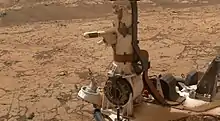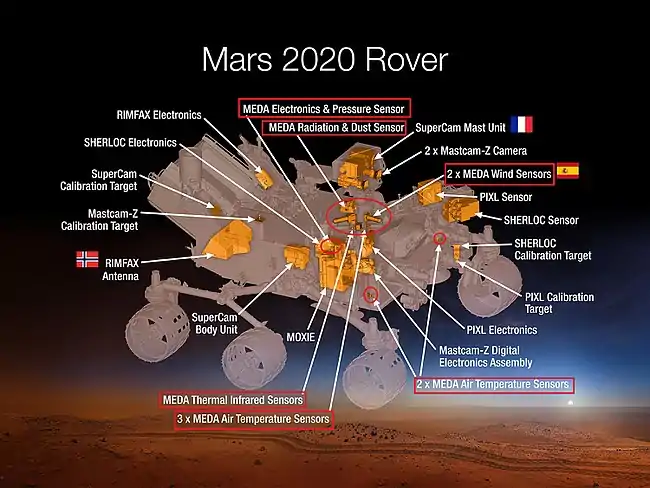Mars Environmental Dynamics Analyzer
The Mars Environmental Dynamics Analyzer (MEDA) is an instrument on board the Mars 2020 Perseverance rover that will characterize the dust size and morphology, as well as surface weather.[2][3] Specifically, the information obtained will help address future human exploration objectives, as dust sizes and shapes, daily weather report and information on the radiation and wind patterns on Mars, that are critical for proper design of in situ resource utilization systems.[2][3] MEDA is a follow-on project from REMS, of the Curiosity rover mission.[4] MEDA has an increased scope, with greater data collection on Mars dust which contributes to overall Mars program objectives and discovery goals.[4]
| Operator | Spanish National Research Council |
|---|---|
| Manufacturer | Spanish Astrobiology Center (CSIC-INTA) |
| Instrument type | Suite of environmental sensors |
| Function | Measure dust size, morphology, weather |
| Mission duration | 1 Mars year[1] |
| Properties | |
| Mass | 5.5 kg (12 lb) |
| Power consumption | 17 watts |
| Host spacecraft | |
| Spacecraft | Mars 2020 Perseverance rover |
| Operator | Spanish National Research Council |
| Launch date | July 2020 (planned) |
| Rocket | Atlas V 541 |
| Launch site | Cape Canaveral SLC-41 |

The instrument suite is being developed and provided by the Spanish Astrobiology Center at the Spanish National Research Council in Madrid, Spain. The Principal Investigator is José Antonio Rodríguez Manfredi.
Overview
Dust dominates Mars' weather the way that water dominates Earth's weather. Martian weather cannot be predicted unless dust behavior is studied and understood in the weather context.[3][5] MEDA is a suite of environmental sensors designed to record dust optical properties and six atmospheric parameters: wind speed/direction, pressure, relative humidity, air temperature, ground temperature, and radiation (UV, visible, and IR ranges of the spectrum).[3][6]
The technology used on MEDA was inherited from the REMS package operating on the Curiosity rover and the TWINS package on InSight lander.[2] The sensors are located on the rover's mast and on the deck, front and interior of the rover's body. It records data whether the rover is active or not, at both day and night.[6] The instruments will collect data for 5 minutes every 30 minutes.[5]
| Parameter | Performance/units[3][6] |
|---|---|
| Mass | 5.5 kg (12 lb) |
| Power | Max 17 watts |
| Data return | ≈11 megabytes |
| Temperature | accuracy: 5 K resolution: 0.1 K |
| Relative humidity | accuracy of 10% in the 200-323 K range |
| Pressure | Range: 1 to 1150 Pa accuracy: 20 Pa resolution: 0.5 Pa |
| Radiation | eight upward looking photodiodes: • 255 +/– 5 nm for the O3 |
| Wind | accuracy: 2 m/sec resolution: 0.5 m/sec |
Meda components

References
- "Mission: Overview". NASA. Retrieved March 7, 2015.
- The Mars Environmental Dynamics Analyzer (MEDA): A Suite of Environmental Sensors for the Mars 2020 Rover. Tamppari, L.; Rodriguez-Manfredi, J. A.; de la Torre-Juárez, M.; Bridges, N.; Conrad, P. G.; Genzer, M.; Gomez, F.; Gomez-Elvira, J.; Harri, A. M.; Lemmon, M. T.; Martinez, G.; Navarro, S.; Newman, C. E.; Perez-Hoyos, S.; Prieto, O.; Ramos, M.; Saiz-Lopez, A.; Sanchez-Lavega, A.; Schofield, J. T.; Smith, M. D. American Geophysical Union, Fall Meeting 2015, abstract #P11B-2097
- Mars 2020 - MEDA Specifications. NASA, 2016.
- MEDA, THE ENVIRONMENTAL DYNAMICS ANALYZER FOR MARS 2020 (PDF). J. A. Rodriguez-Manfredi, M. de la Torre, J. S. Boland, et al. 3rd International Workshop on Instrumentation for Planetary Missions (2016).
- Mars Environmental Dynamics Analyzer (MEDA). Mars 2020 Rover, NASA. 2015.
See also
- Martian soil (aka regolith)
- Atmosphere of Mars
- Materials Adherence Experiment (1996 Mars dust experiment on Mars Pathfinder)
